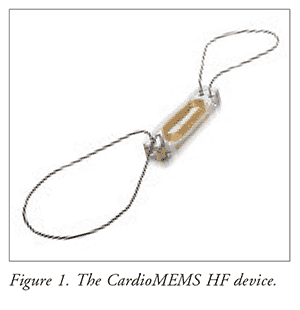US Pharm. 2016;41(2):HS-11-HS12.
Heart failure is a complex condition that results from any structural or functional impairment of the heart’s ability to pump blood. The cardinal manifestations of heart failure are dyspnea and fatigue, which may limit exercise tolerance and lead to congestion and edema.1 Heart failure results from disorders such as coronary artery disease, hypertension, and diabetes, with most patients experiencing symptoms due to impaired left ventricular myocardial function. The ejection fraction, or the percentage of blood leaving the heart each time it contracts, is used to classify the severity of heart failure.2
Currently, monitoring and management of heart failure symptoms consists of controlling blood pressure and body fluid volume. Changes in body fluid volume are of particular concern because congestive symptoms are present in more than 90% of patients admitted for decompensated heart failure, regardless of ejection fraction. Measurements taken in the patient’s home, such as blood pressure or body weight, are prone to error, necessitating an improvement in home monitoring of heart failure symptoms.3
Epidemiology
The lifetime risk of developing heart failure is 20% for Americans aged 40 years or older, with approximately 650,000 new heart failure cases diagnosed annually. Heart failure incidence increases with age, rising from approximately 20 per 1,000 individuals aged 65 to 69 years to more than 80 per 1,000 individuals aged 85 years or older. Approximately 5.1 million persons in the United States have clinically manifested heart failure, and the prevalence continues to rise. Disparities in the epidemiology of heart failure have been identified, with African Americans having the highest risk for this disease. Although survival has improved, the absolute mortality rates for heart failure remain approximately 50% within 5 years of diagnosis. The total cost of heart failure care in the U.S. exceeds $30 billion annually, with over half of these costs spent on hospitalizations.1
Device
The CardioMEMS HF system includes a wireless sensor that measures changes in pulmonary artery pressure and sends pressure readings to an external patient electronic system. The sensor is implanted into the distal pulmonary artery during right heart catheterization. An electronic unit placed next to the patient’s bed powers the implant wirelessly and also collects the readings. Readings measured include heart rate and systolic, diastolic, and mean pressures. These readings are then sent to the patient’s cardiologist via an online portal.4 An image of CardioMEMS HF and patient instructions are shown in FIGURE 1 and TABLE 1, respectively.

Efficacy
The CHAMPION trial evaluated the efficacy of the CardioMEMS HF system.5 In this trial, 550 patients with a diagnosis of NYHA (New York Heart Associatin) Class III heart failure and hospitalizations due to decompensated heart failure in the 12 months preceding trial enrollment had a permanent pressure sensor successfully implanted in their pulmonary arteries during right heart catheterization. The treatment group had their daily pressures uploaded and monitored in order to guide heart failure treatment strategies, while the control group was handled using standard heart failure management strategies such as weight monitoring.5The CHAMPION trial found that the CardioMEMS HF system reduced the relative risk for heart failure hospitalizations over the 6 months of the study by 50% in patients with an ejection fraction greater than or equal to 50%, by 46% in patients with an ejection fraction greater than or equal to 40%, and by 24% in patients with an ejection fraction <40%. Furthermore, the study showed that patients whose pressure data were uploaded and monitored received more medical interventions. Changes in diuretic and vasodilator therapies were instituted in the treatment group, and these therapy amendments contributed to the decrease in hospitalizations.5
Conclusion
Heart failure is a progressive condition that causes significant morbidity and mortality in the U.S. and is associated with high healthcare costs. Preventing decompensation is crucial in heart failure management, and the CardioMEMS HF system has been shown clinically to provide a safe and effective means for monitoring symptoms and reducing hospitalizations due to heart failure. For any technical difficulties during the use of the CardioMEMS HF system, patients can call technical support at 1-877-696-3754. For more information about heart failure, visit www.heartfailure.com.
REFERNCES
1. Yancy CW, Jessup M, Bozkurt B, et al. 2013 ACCF/AHA guideline for the management of heart failure: a report of the American College of Cardiology Foundation/American Heart Association Task Force on Practice Guidelines. J Am Coll Cardiol. 2013;62(16):1495-1539.
2. National Heart, Lung, and Blood Institute. What is heart failure? www.nhlbi.nih.gov/health/health-topics/topics/hf. Accessed November 5, 2015.
3. Bhuiyan T, Maurer MS. Heart failure with preserved ejection fraction: persistent diagnosis, therapeutic enigma. Curr Cardiovasc Risk Rep. 2011;5(5):440-449.
4. St. Jude Medical, Inc. CardioMEMS HF System. http://professional.sjm.com/
therapies/cardiomems/home. Accessed November 5, 2015.
5. Adamson PB, Abraham WT, Bourge RC, et al. Wireless pulmonary artery pressure monitoring guides management to reduce decompensation in heart failure with preserved ejection fraction. Circ Heart Fail. 2014;7(6):935-944.
To comment on this article, contact rdavidson@uspharmacist.com.






